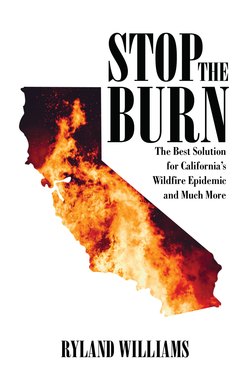Читать книгу Stop The Burn - Ryland Williams - Страница 1
На сайте Литреса книга снята с продажи.
Introduction
ОглавлениеCalifornia is on fire, and without major policy change, California will continue to burn. The firestorms that began in October of 2017 became the most destructive and deadly in California history, only to be exceeded by the wildfires of 2018, which became the most devastating to date. There is without question, a wildfire epidemic in California.
To put these fires in the proper perspective, the 1991 Tunnel Fire, in the hills of Oakland and Berkeley, was previously California’s most destructive and deadly fire. The fire burned 1,520 acres, destroyed 3,280 residential units, and caused 25 fatalities. The Tubbs Fire in Napa and Sonoma counties, the most devastating wildfire of the many firestorms of 2017, burned 36,807 acres, destroyed 5,643 structures, and caused 22 deaths. In 2018, the Camp Fire in Butte County, the most destructive and deadly of the many wildfires that year, burned 153,336 acres, destroyed 18,804 buildings, and caused 88 civilian fatalities. In all, there were 8,527 wildfires burning in 2018. They burned 1,893,913 acres of land, the largest amount of burned acreage in California history.
In 1964, as a teenager, I had volunteered to fight the Hanly Fire in Sonoma County. Of significance, is the fact that this fire had burned almost the identical area as the Tubbs Fire that I witnessed 53 years later. But times have changed, and there was nothing similar about the destruction.
By experiencing the Tubbs and Nuns fires first hand, I developed quite an interest in the firestorms of 2017. The smoke had just cleared, when law firms from everywhere, converged on Santa Rosa with the anticipation that PG&E was at fault for the Tubbs Fire. They set up shop expecting to break the bank. In 2018, Cal Fire released in its report, that PG&E’s power lines were the cause of most of the 2017 fires. I physically visited several sites of the fires origins, and while the power lines had provided the spark, it was abundantly clear that trees and overgrown vegetation had provided the fuel for these firestorms.
Since the firestorms of Oct. 8, 2017, I have read every available article that was published about California’s wildfires, and the almost daily articles chronologically tracking PG&E’s fight to survive. I have read most, if not all, of the so called experts' solutions to California’s wildfires. I found many to be extremely disappointing. By spending all of my life in California, I have become quite familiar with our wonderful forests and open space. While working in real estate development, I worked with different fire agencies to incorporate fire prevention and safety into our projects. After witnessing three wildfires and their destruction first hand, I have realized, that with no realistic prevention plan in sight, the firestorms of the future will only become worse.
I have developed a solution. Over 90% of the recent firestorms were caused by electrical power lines coming in contact with combustible vegetation. My plan will prevent most, if not all of these fires. We cannot allow California to continue to burn, and if my plan is enacted, there is a bonus. This plan will provide several extremely positive social and economic benefits for the state of California and for many of the workers participating in the plan. For those not in California, my plan might also work for you.
